ROADSIDE REVEGETATION
An Integrated Approach to Establishing Native Plants and Pollinator Habitat
3.9 Identifying Factors That Affect Pollinators
For projects where one of the objectives is to improve pollinator habitat, it is important to identify the core habitat elements supporting local pollinator populations. Similar to identifying limiting factors to plant establishment, as discussed in Section 3.8, the designer evaluates a project area for how well it supports a diversity of pollinators prior to construction and identify those factors important for improving pollinator habitat on roadsides after project construction.
The Pollinator Habitat Assessment Checklist (Table 3-7) is a guide to assessing current and potential habitat conditions based on information collected during the field information planning phase (Section 3.3 and Section 3.6). While the checklist provides habitat characteristics important for most pollinator habitats, the designer may want to modify the checklist to also include the climate, soils, vegetation, and pollinator species of interest specific to the project area and project objectives.
Once the designer has assessed the current condition of the pollinator habitat and identified parameters that are limiting to pollinator populations, a list of mitigating measures can be developed. Mitigating measures are site treatments that will improve pollinator habitat. For example, if breeding habitat is limiting, a mitigating measure is to include butterfly host plants. There are usually several ways to mitigate each limiting factor and designers can select the measures that most suit their site conditions and objectives discussed in the following section.
3.9.1 Nectar and Pollen Sources
Pollinators such as beetles, flies, wasps, moths, butterflies, bees, hummingbirds, and bats all forage for food on flowers. Nectar and pollen are sources of carbohydrates and protein, respectively, for pollinators. The act of pollination is an incidental effect of feeding or gathering food: animals visit flowers seeking sustenance, and in the process transfer pollen grains which allow flowering plants to reproduce.
Flowering plants in roadsides are important sources of nectar and pollen for pollinators that reside within the roadside habitat (e.g., Munguira and Thomas 1992) as well as those that use the roadside as a partial habitat for foraging but reproduce or overwinter elsewhere (e.g., Ouin and others 2004). Adults of bees, butterflies, wasps, hummingbirds, and many species of flies, moths, beetles, and bats feed on nectar to maintain their energy levels. Some adult beetles and flies require the protein that pollen provides in order to reproduce. Female bees actively collect pollen to take back to their nests (Figure 3-73), where they provide for their offspring by leaving a supply of pollen moistened with nectar. The availability of pollen and nectar influences the abundance and diversity of pollinators found on roadsides (Saarinen and others 2005; Hopwood 2008).
Figure 3-73 | Bees and other pollinators rely on flowering plants as sources of food
In this picture, a female long horned thistle bee (Melissodes desponsa) collects pollen from a tall thistle (Cirsium altissimum) and stores it on her hind legs to transfer it back to her nest, where she will leave it for her young to eat.
Photo credits: Jennifer Hopwood/Xerces Society
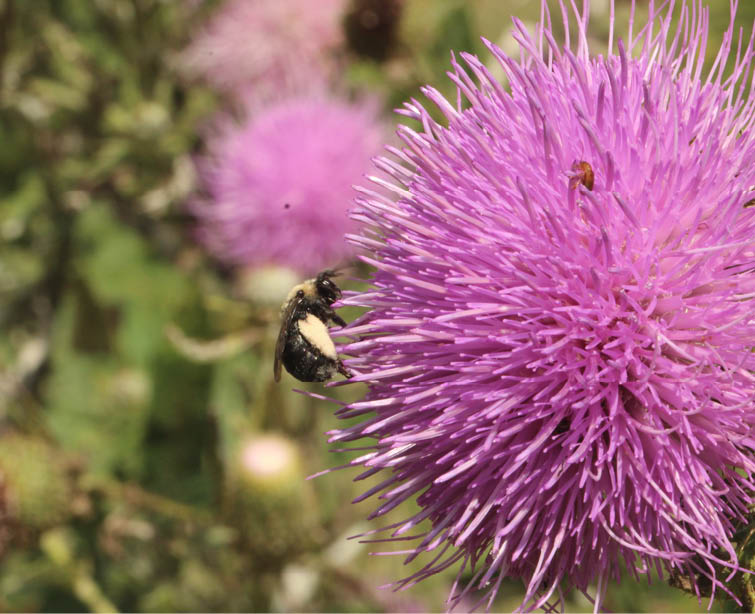
Attractiveness and Overlapping Bloom Times
It is important to include plants that are known to provide floral resources and attract pollinators. Native plants are more attractive to native pollinators than exotic plants, even when both plant types are present in sites (Hopwood 2008; Williams and others 2011; Morandin and Kremen 2013a). Some species of native plants are particularly attractive to a wide range of pollinators, offering either large quantities of nectar, high quality nectar, or pollen with high protein content. Sourcing plant material locally or within the ecoregion is best for pollinators because the phenology (flowering period) can also differ with the provenance of the plant material (Norcini and others 2001; Houseal and Smith 2000; Gustafson and others 2005) (Section 3.3.3 and Section 3.13.2). Bloom times of non-locally sourced plants have the potential to be out of sync with pollinators. This may be particularly problematic for bee species that are pollen specialists (e.g. Melissodes desponsa, a pollen specialist on thistles, Figure 3-73) and are reliant on the pollen from a small subset of plants and time their emergence from overwintering with the bloom time of their host plants.
Additionally, it is important to have flowers available to pollinators throughout the growing season. While pulses of bloom can provide critical resources to pollinators, sustained resources create functional habitat throughout the growing season to best support robust populations and communities. For example, solitary bees have distinct flight seasons that last 4 to 6 weeks. Bees that emerge early in the growing season can begin to forage in February in warmer parts of the U.S., with late-season bees foraging through October. Social bee species have overlapping generations and require forage throughout the growing season.
Gaps in bloom early in the spring or late in the fall are can be easily overlooked during the planning stages, but these are times when nectar and pollen are very important to the health of pollinators such as bumble bees, honey bees, and migrating monarch butterflies. Early-season pollen and nectar sources are important for those species that have flight seasons in the spring and will lead to greater reproduction of those species. Early season forage is also important for pollinators like bumble bees and honey bees that fly all season long but that are in need of floral resources early in the spring after overwintering. Late season flowers provide resources that ensure that queen bumble bees have ample food going into winter hibernation, and that honey bee colonies have enough food stores to last through the winter.
The availability of pollinator-friendly plant species and overlapping bloom times at a site prior to construction can be assessed by recording the plant species that are flowering and their percent cover every 2 to 4 weeks starting at the beginning of the growing season through the fall (February through October in California). These vegetation surveys would be conducted on both the project site and undisturbed reference sites (Section 3.6.1).
It is best to have a minimum of 3 to 5 species of trees, shrubs, or wildflowers blooming during each season (spring, summer, fall). Ideally there would be 5 to 10 species blooming per season, overlapping to ensure availability of resources to the entire pollinator community. Increasing the diversity of flowering plants in seed mixes and planting plans can help to prevent gaps in bloom. If flowering species have been recorded at reference sites during the growing season, these species can be used to develop a list of species with overlapping blooms for the revegetation project. When field surveys have not been conducted, a species list using the ERA tool can be used to generate lists of the recommended workhorse and pollinator-friendly plant species for all EPA Level III ecoregions in the continental United States. The ERA will also denote the bloom periods of the plant species and which general groups of pollinators the plant species will benefit.
Floral Diversity and Cover
Whenever possible, it is best to increase the diversity of wildflowers and blooming shrubs or trees. Pollinator diversity increases with increasing flowering plant diversity (Potts and others 2003). Different pollinators have different floral needs and preferences, so including a diversity of plant species with different flower shapes, sizes, colors, and growth habits helps support the greatest abundance and number of species of pollinators (Ghazoul 2006; Ponisio and others 2015). Additionally, greater flowering species provide greater diversity of pollen and nectar sources for honey bees. Diversity in diet can help support honey bee immune system health (Alaux and others 2010; Di Pasquale and others 2013).
Floral cover is also important; having sparse resources will not sustain pollinator populations whereas high densities of blooms are more attractive and can support higher numbers of pollinators (Herrera 1998). For example, it is best for pollinator habitat to maximize the percentage of wildflowers included in revegetation projects involving herbaceous plants (Figure 3-74). The combination of grasses and wildflowers can effectively resist weed colonization and provide soil stabilization. A planting seed mix that consists of grass species at 50 percent or less of the seed mix volume can prevent the grasses from outcompeting the wildflowers. It is ideal to aim for 45 percent cover of flowering plant vegetation across a growing season. For example, flowering plant cover could be spread out throughout the growing season, with 15 percent cover of vegetation in spring, 15 percent in summer, and 15 percent in autumn.
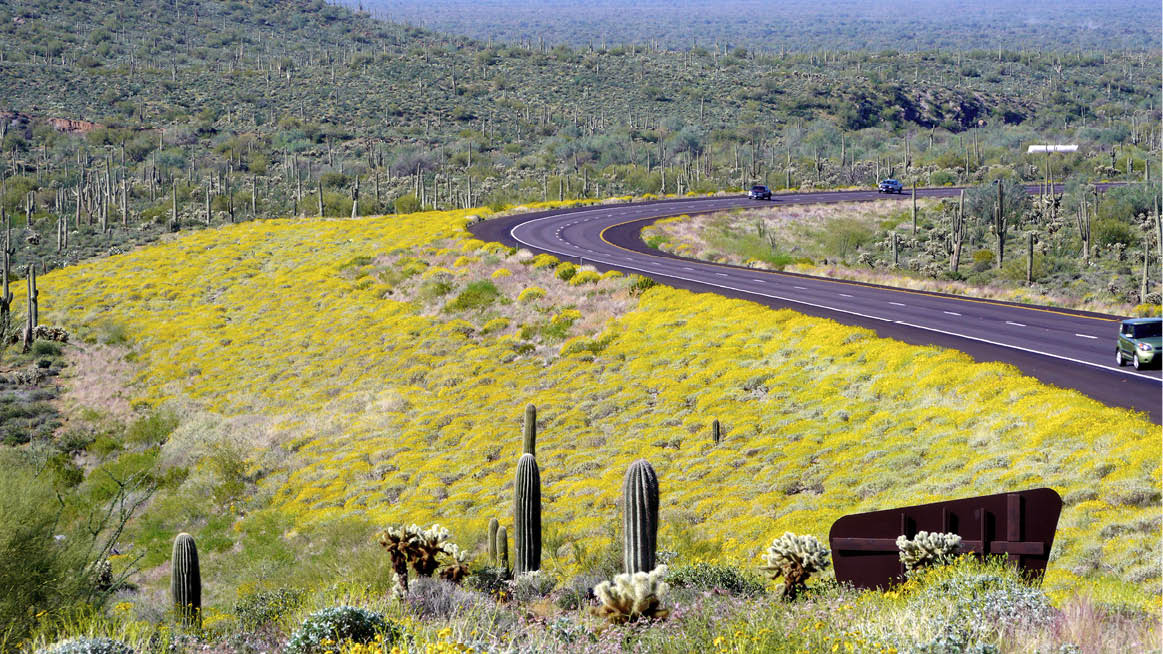
Figure 3-74 | High plant diversity and floral cover are important for pollinators
This roadside through the Tonto National Forest in Arizona has high plant diversity and high floral cover, two characteristics that are valuable for pollinators.
Photo credit: Arizona Department of Transportation
It can be helpful to emulate the species diversity found on reference sites located in nearby natural plant communities. Diverse plantings that resemble natural communities are the most self-sustaining and long-lasting plantings because they better resist weed invasions and pest outbreaks. A general walk through of the area may be enough to identify flowering species or a more intensive sampling can be conducted using monitoring procedures described in Chapter 6.4. The Species Presence monitoring procedure (Section 6.3.3) can be used to record floral diversity and the Species Cover monitoring procedure (Section 6.3.2) can be used to record floral cover.
When working at sites with low diversity and floral cover, clumping single species together can benefit pollinators (Frankie and others 2002). For example, planting small clusters of single species of flowering plants to form patches of color when in bloom helps pollinators to spot the plants quickly. This is especially helpful for pollinators searching landscapes for limited resources and also helps pollinators to move quickly and efficiently between flowers to collect the resources they need. In larger plantings, clusters are less important as long as flowering plants are abundant.
Floral cover and diversity increases with site productivity. By improving soil characteristics, floral cover and diversity will increase. On projects where resources are limited, areas important for pollinator habitat can be identified and soil improvement conducted specifically in those areas.
3.9.2 Breeding Habitat
Pollinators have diverse habitat needs for breeding, in particular for their egg-laying sites. The habitat needs for insect pollinators are especially varied because insect pollinators select locations in which to lay their eggs based on the needs of their larvae. The main groups of insect pollinators, bees, beetles, flies, moths, butterflies, and wasps, all have four distinct life stages: egg, larva, pupa, and adult. Eating and growing are the primary functions of the larval stage, followed by the dormant pupal stage during which body tissues rearrange and transform into the adult stage. The primary goal of the adult stage is reproduction. The needs of pollinator larvae are often different than the needs of adults. For example, the eggs of some beetles and flies are laid near prey on vegetation or in the leaf litter so that their larvae, which are predatory, have access to the food resources they need. Butterfly and moth larvae (also known as caterpillars) consume vegetation and are found on the leaves and stems of plants, and their eggs are laid on certain species of host plants preferred by their larvae. Bees and predatory wasps construct nests in which to lay their eggs (Section 3.9.3). Roadsides can serve as breeding habitat for all of these and more.
Host Plants
Egg-laying sites for butterflies and moths consist of plants upon which the adult will lay eggs and the larvae will feed after hatching (Figure 3-75). Some butterflies and moths may rely on plants of a single species or genus for host plants. For example, caterpillars of the monarch butterfly feed only on species of milkweed (Asclepias spp.) and closely related genera. Some species are even more specialized; caterpillars of the Karner Blue butterfly (Lycaeides melissa samuelis) will only survive on lupine (Lupinus perennis). Other species may exploit a wide range of plants. The larvae of some swallowtails (Papilio spp.) can feed on a range of trees, shrubs, and wildflowers. Given this lifecycle pattern, establishing caterpillar host plants is recognized as a way to sustain butterfly and moth populations (Croxton and others 2005; Feber and others 1996). Roadsides with host plants can support habitat generalist butterflies as well as habitat specialists and migrant species such as the monarch butterfly (e.g., Ries and others 2001; Kasten and others 2016).
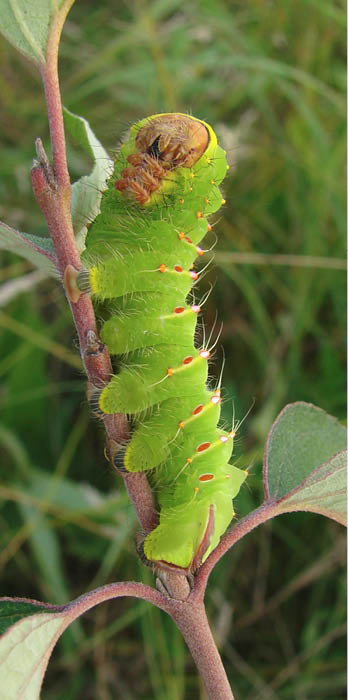
Figure 3-75 | Caterpillars, butterflies, and moth larvae devour plant material
This giant silkworm moth (Antheraea polyphemus) will feed on a number of host plant species, including maples (Acer) and plums (Prunus).
Photo credit: MJ Hatfield
There are two main considerations for assessing whether butterflies and moths are using the site for breeding: (1) if host plant species are present within the site and (2) if present, if eggs and/or caterpillars of butterflies and moths are also present at the site. If the goals of the project include supporting particular species of butterflies or moths, it is useful to monitor the presence of the host plants of the target pollinator species. Section 6.4.3 includes a monitoring procedure for host plant abundance and population estimates of a target species (e.g. monarch butterfly) based on counts of eggs and caterpillars.
Many plants used in revegetation projects serve as butterfly and moth host plants, but it may be necessary to include additional species to support particular butterflies or moths. For example, planting milkweeds will contribute to the recovery of the monarch butterfly (Inset 3-5). The ERA tool includes information about the host plant needs of target butterfly and moth species. For additional information, see the HOSTS database of the world's Lepidopteran host plants created by the Natural History Museum, London. The database can be searched by either plant species or Lepidopteran species.
Inset 3-5 | Milkweeds and adjacent landowner concerns
Increasing milkweed populations in North America is critical to the recovery of the monarch butterfly, but one obstacle to widespread inclusion of milkweeds in new plantings is the perception that milkweeds are in fact weeds. Concerns include:
- the potential for milkweeds to expand from the original planting site and encroach on adjacent land, and
- the chemical compounds present in milkweeds and their toxicity to livestock.
Although milkweed, the common name for plants in the genus Asclepias, implies that the plants are indeed weeds, milkweeds are a diverse group of native wildflowers with nearly 100 species in the U.S. that are not listed as noxious weeds at either the State or the federal level in the U.S. Milkweeds may be perceived as weeds because a few species will colonize disturbed areas and tend to reproduce vegetatively (in addition to reproduction by seed), sending up new shoots from roots that spread outward from the parent plant. This clonal reproduction allows their populations to expand over time, and plants may spread out of their original area. Common milkweed (Asclepias syriaca) exhibits the highest degree of clonal reproduction, and vegetative growth also occurs to a lesser degree in horsetail milkweed (A. subverticillata), narrowleaf milkweed (A. fascicularis), plains milkweed (A. pumila), prairie milkweed (A. sullivantii), showy milkweed (A. speciosa), and whorled milkweed (A. verticillata) (Borders and Lee-Mader 2014). Despite their vegetative growth, many of these species are unlikely to create an ongoing and unmanageable weed problem for roadside managers or adjacent landowners. However, the issue can also be avoided by selecting from the many milkweed species that do not reproduce clonally.
Another contributing factor to the perception of milkweeds as actual weeds is the presence of cardenolides, steroid plant compounds milkweeds use as a defense against herbivores. The amount of cardenolides present in plant tissue varies with the species of milkweed (it can also fluctuate seasonally) and can make the plants potentially toxic to livestock (Burrows and Tyrl 2013). Farmers and ranchers with livestock are often concerned about the presence and proximity of milkweeds to their stock. However, in properly managed rangeland and pasture, milkweed should pose no risk to livestock. Milkweeds are toxic only if consumed in large quantities, and milkweeds are highly unpalatable (Fulton 1972). Livestock, cattle in particular, will only consume milkweeds in the absence of other forage; a pasture must be barren in order for milkweed to poison a cow. Milkweed poisoning can be prevented by maintaining a sustainable stocking rate and by verifying that sources of hay are milkweed-free (milkweed retains its toxicity when dry and may increase in palatability).
Egg-Laying Sites
The breeding habitat needs are less understood for groups of pollinators beyond butterflies and bees, though what is known suggests that egg-laying sites for beetles, flies, and other pollinators are usually close to food sources for their larvae. If larvae are carnivorous, as is the case for lady beetles, eggs are laid on vegetation near their aphid prey, while syrphid or flower fly species that consume detritus or other decomposing materials as larvae lay their eggs in leaf litter. Egg-laying sites can include moist soil, leaf litter or plant debris, on foliage near prey, or in crevices under bark or rocks (Table 3-11).
Soil cover can potentially serve as a proxy for egg-laying sites for some pollinators. A monitoring procedure for measuring soil cover is presented in Section 6.3.1. Visual scans of vegetation can be used to identify colonies of aphids, whiteflies, or other clusters of plant feeders that serve as egg-laying sites for pollinator species with predatory larval stages (e.g. flower flies).
Table 3-11 | Egg-laying sites for pollinators
Pollinator group |
Egg-laying sites |
Beetles |
In crevices, in the soil, on leaves, under plant debris or in leaf litter, on foliage near prey |
Bees |
In nests (Section 3.9.3) |
Butterflies and moths |
Host plants |
Flies |
On foliage among prey, on larvae (for parasitic species), in leaf litter |
Wasps |
In nests (Section 3.9.3) |
Bats |
Breeding habitat unknown but bear live young in roosts such as caves, bridges, etc. |
Hummingbirds |
Eggs in nests, often in forks of branches of trees and shrubs |
3.9.3 Nesting Habitat
Bees and predatory wasps provide for their young by constructing and provisioning nests in which their offspring develop. Bees provision their nests with pollen and nectar as food sources for their young, while predatory wasps supply their young with prey to consume. Some species of bees and predatory wasps nest underground, while others nest in tunnels and in cavities. Nesting is a critical factor affecting the ability of bees to persist within a site (Winfree 2010; Menz and others 2011; Morandin and Kremen 2013b).
Soil as Pollinator Nesting Habitat
Most of North America's native bee species (about 70 percent) nest in the soil. Ground nesting bees provide for their young by excavating nests in the soil. Their offspring develop underground in cells (also known as brood chambers). Ground nesting bees need access to soil surfaces between vegetation to excavate and access their nests (Michener 2007). Some species will nest in a variety of soils while others have very specific requirements for the soil type, moisture, alkalinity, slope, and aspect (Cane 1991).
Many ground-nesting bees prefer to nest in sunny, bare patches of soil (Linsley 1958; Sardiñas and Kremen 2014). Such patches can be found under wildflower plantings where small areas of bare ground are exposed between plants (Figure 3-76A) or around the bases of native bunch grasses that tend to grow in dense bundles. Providing openings in scrub or forest habitat can promote ground-nesting bees (Figure 3-76B). Bunch grasses tend to provide better nesting habitat than sod-forming grass species, and roadsides with native bunch grasses have more nesting opportunities for ground-nesting bees and, consequently, a greater abundance of ground-nesting bees (Hopwood 2008). Bunch grasses also allow establishment of other desirable species and prevents colonization from rhizomatous species. Undisturbed areas of bare ground can facilitate nesting activity (Potts and others 2005; Winfree and others 2009; Williams and others 2010; Roulston and Goodell 2011).

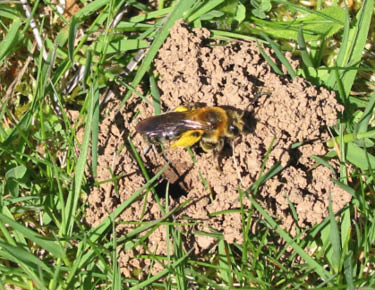
Figure 3-76 | Ground nesting bee nests
The entrances of ground nesting bee nests often have small piles of excavated soil around them. Bees can nest in areas of bare ground (A) or amongst vegetation (B).
Photo credits: Eric Lee-Mader/Xerces Society (A) and Jennifer Hopwood/Xerces Society (B)
Assessment of patches of bare ground or patchy plant cover can be made through measurements of soil cover. A monitoring procedure for measuring soil cover is presented in Section 6.3.1. Ideally, patches of non-erodible bare ground would be present and cover approximately 5 percent of the project site. If using thick mulch during establishment, it can benefit ground nesting bees and wasps if there are small patches of bare soil left without mulch. Another idea for creating a permanent area of bare soil is to have short sections of cut slopes or banks that are very steep and constantly raveling, preventing plants from establishing. These sections would need to be away from water so that soil would not erode into the stream system.
Stems and Tunnels
A number of above-ground nesting bees nest in hollow stems or excavate pithy stems (e.g., elderberry or cane fruits) (Figure 3-77A). Many of these plants provide resources to other wildlife, such as berries (e.g., Salmonberry). Other native bees nest in tunnels in wood, such as abandoned beetle tunnels in logs, stumps, and snags (Michener 2007) (Figure 3-77B). Where site appropriate, planting native wildflowers with pithy stems, such as cupplant (Silphium perfoliatum), ironweeds (Vernonia spp.) and sunflowers (Helianthus spp.), along with shrubs such as wild rose (Rosa spp.), elderberry (Sambucus spp.), sumac (Rhus spp.), yucca (Yucca spp.) or agave (Agave spp.), will provide resources for stem-nesting bees.
Figure 3-77 | Bee nest construction
Bees can construct nests by excavating pithy stems (A) or in old beetle borer holes (B).
Photo credits: Jennifer Hopwood/Xerces Society
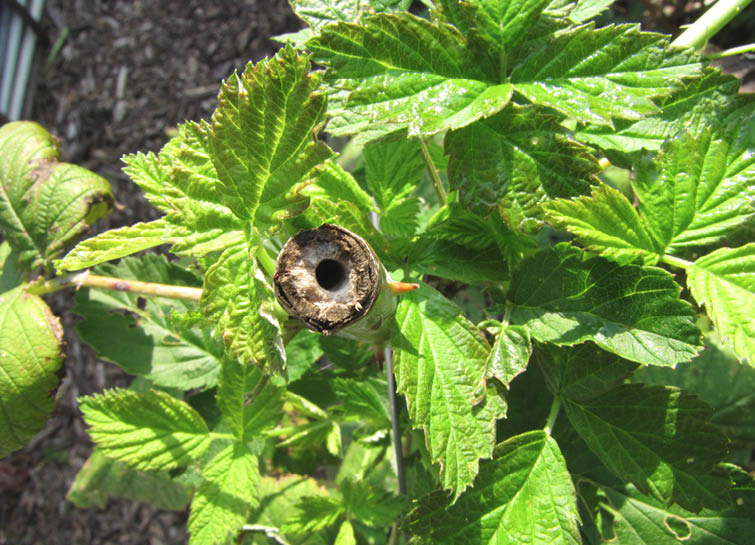
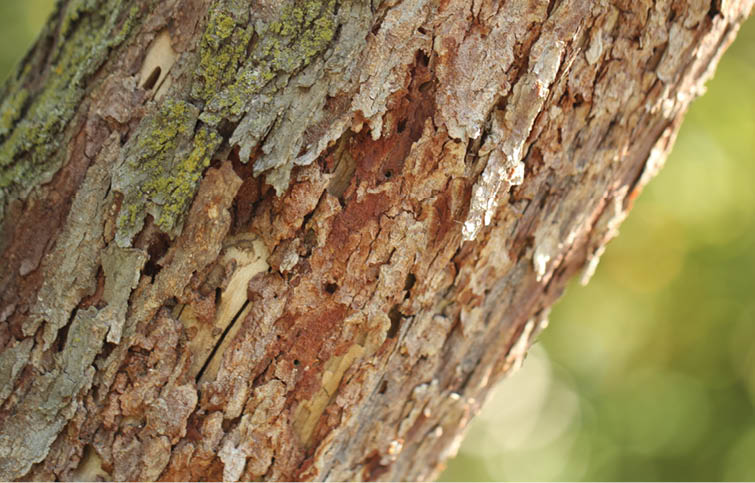
Assessment of potential tunnel nest sites can involve identifying woody plants (species and numbers) that support tunnel-nesting bees that can be planted at the project site. Additionally, because many tunnel nesting species create their nests in tunnels originally built by other insects (e.g., beetles), in old wood, such as snags, or living tree trunks, it can be useful to quantify the amount of dead wood, snags, or wood with holes in it (e.g., fence posts) that already exist at the site or that can be established within the project site.
The best method for increasing nesting habitat for tunnel nesting bees (and predatory wasps with similar nesting habits) is to plant woody vegetation used by bees and to maintain snags or downed wood. A minimum of three species of woody plants or pithy stemmed plants is recommended, though a good rule-of-thumb is to include at least five species. The ERA tool provides information about plants that provide nesting resources for bees. Maintaining or importing dead wood, snags, or wood with holes in it (e.g., fence posts) within the project site will also benefit tunnel nesting bees.
Cavities

Figure 3-78 | Grass thatch is good nesting habitat
There isn't much to see from the surface but this grass thatch was home to a healthy colony of eastern bumble bees (Bombus impatiens).
Photo credits: Jennifer Hopwood/Xerces Society
Most native bees are solitary and nest either in the ground or in wood or pithy stems. Bumble bees, however, are social and have different nesting requirements. Bumble bees form social annual colonies founded by a single queen in the spring. A bumble bee colony can grow in size through the spring and summer as the bees work cooperatively to raise offspring and find food. At the end of summer, if the colony is healthy, new queens are produced. Queens find mates in the fall, their natal colonies die off, and queens find a place to overwinter, such as in leaf litter or under a shallow layer of soil. Bumble bee colonies require an insulated cavity in which to nest, such as underneath grass clumps (Svennson and others 2000), under the thatch of bunch grasses (Figure 3-78), or under rocks (Hatfield and others 2012). Bunch grasses have a tendency to "lodge" at maturity, meaning they create a gap between the grass and the soil surface that can provide an ideal nesting cavity for bumble bee colonies (Svennson and others 2000; Hatfield and others 2012). Mowing and grazing can have negative impacts on bumble bee colonies (Hatfield and others 2012). If a colony is destroyed via mowing mid-growing season, no queens will be produced, which can lower population levels the following year.
The nest entrances to bumble bee nests can sometimes be located in wood piles. In addition, wild bees may use holes in wood in woodpiles for nest entrances. Wood piles are also attractive to other wildlife, including birds. If non-native woody vegetation is being removed from a project site, leaving some of the wood piled at the edges of the habitat into one or more brush piles can provide nesting locations and also support populations of ground beetles.
Assessment of nesting habitat for bumble bees involves counting the number of different native bunch grass species present, calculating the relative area of the site bunch grasses cover, and noting if downed wood is present at the site.
If native bunch grasses are adapted to the site, it is best to have at least one native perennial bunch grass species present, covering at least 2 percent of site. Ideally there would be at least 2 different species in each project site. If woody vegetation is removed from the site, leave at least 1 wood or brush pile. It is also important to maintain areas of unmown bunch grasses throughout the growing season to support bumble bee nests.
3.9.4 Water Sources
Pollinators utilize water in multiple ways. Some directly consume water, while others use it to construct nests or for evaporative cooling. Pollinators can obtain water from edges of water sources, drops on vegetation, wet soil, puddles, or small pools on rocks.
Water, Mud, Minerals
Although pollinators typically obtain much of the water content they need by consuming nectar, water is also consumed directly on occasion or is collected by pollinators for hydration or evaporative cooling. On warm days it isn't unusual to see bumble bees gathered around the edges of puddles or perched on rocks in streams to sip water. Honey bees will collect water and transport it back to their hive in the heat of the summer to spread the water lightly over their brood and fan them with their wings to reduce the temperatures within the hive via evaporative cooling. Honey bees will also use water to dilute stores of crystalized honey within their hive. Water can also be used by ground nesting bees or wasps that carry it to the soil to moisten hard dry ground to make it easier to dig their nest tunnels.
A number of wild native bees and wasps utilize mud in their nest construction (Figure 3-79). Blue orchard bees (Osmia lignaria) collect mud and use it to create nest chambers for their offspring. Blue orchard bees so rely on mud that the females will not nest in areas without a source. Potter wasps (Hymenoptera: subfamily Eumeninae) also use mud as nest partitions within an existing cavity, as well as free-standing mud structures. Mud-puddling is a behavior to gather liquid nutrients exhibited by butterflies and some other pollinators in which they congregate on wet soil to gather minerals and nutrients needed for their health.
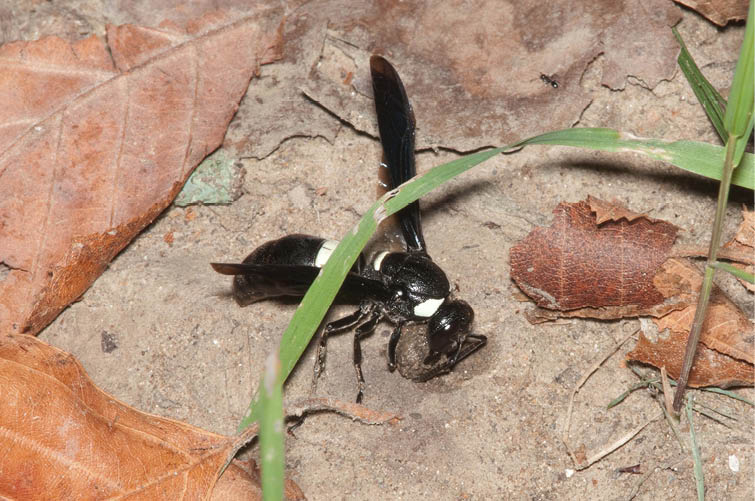
Figure 3-79 | Wasps build their nests from mud
This female potter wasp is collecting mud in order to build her nest.
Photo credit: Betsy Betros
Water sources for pollinators can include culvert outlets, ditches, draws, gullies, and intermittent streams. Water runoff from the edge of the pavement can also create a source of mud for pollinators.
It may not be practical to include a potential water source in every revegetation plan. It also may not be a conservation priority for pollinators. As mobile animals, pollinators can fly to obtain the water or mud they need from surrounding land. However, projects that incorporate topographic enhancements into the roadside design will increase the potential for temporary surface water and mud sources (Section 5.2.8).
3.9.5 Shelter and Overwintering
Like other animals, pollinators rely on various places that provide shelter during inclement weather. High winds, rain, cool temperatures, cloudy days, and other weather conditions all force pollinators to seek shelter. Pollinators are a diverse group of animals with a diverse set of needs for shelter and overwintering habitat (Table 3-12). Some rely on vegetation, such as the structure provided by grasses or the cover trees and shrubs provide. Others use rocks or crevices as shelter.
Pollinators also need a place in which to overwinter during the dormant season. Overwintering sites for most species are close at hand. Syrphid fly species and soldier beetles overwinter in roadside soil or litter (Schaffers and others 2012), and butterflies and moths also utilize roadsides as overwintering habitat (Schaffers and others 2012). However, a few species travel long distances to overwinter in warmer locations. Examples of migratory pollinators include monarch butterflies, painted lady butterflies, lesser long-nosed bats, and hummingbirds.
Table 3-12 | Shelter and overwintering sites for pollinators
Pollinator group |
Egg-laying sites |
Beetles |
Larvae overwinter in loose soil or leaf litter Adults shelter under rocks, logs, brush |
Bees |
Adults take shelter in bad weather under leaves on plants; overwintering of most species occurs In nests (Section 3.9.3), but queen bumble bees overwinter under shrubs or in shallow soil and leaf litter. |
Butterflies and moths |
Shelter in structure of vegetation; Overwinter in a protected site such as a tree, bush, tall grass, or a pile of leaves, sticks, or rocks |
Flies |
Pupae and adults overwinter in soil or leaf litter |
Wasps |
In nests (Section 3.9.3) |
Nectar-feeding bats |
Caves, mines, rock crevices, tree bark, under bridges and within bridge structures |
Hummingbirds |
Shelter in trees and shrubs; some are resident and some overwinter in southwest U.S., southern Mexico, and Central America |
Woody Vegetation and Grasses
Woody vegetation such as trees and shrubs can provide cover during the growing season that can serve as shelter for pollinators, and can also provide niches for overwintering. Some pollinators will overwinter under bark or in the soil just under shallow roots, or in piles of brush. Grasses can provide shelter for a variety of pollinators but notably for butterflies on roadsides (Saarinen and others 2005), and the root systems and grass thatch can also serve as overwintering habitat.
Assessment of shelter and overwintering habitat can involve identifying woody plants and grasses (species and numbers) that can be planted at the project site. It may be useful to calculate the relative area of the site that grasses cover. Refer to the monitoring procedures for soil cover (Section 6.3.1) and species cover (Section 6.3.2) for additional information.
Including a diversity of types of plants in revegetation plans can help to ensure that vegetation structure that can act as shelter and overwintering habitat is present. Trees and shrubs may not be appropriate for every revegetation project; in those situations, including a diversity of grasses both cool and warm season grasses can increase vegetation structure.
3.9.6 Landscape Connectivity
With habitat becoming increasingly fragmented (Saunders and others 1991), landscape connectivity is important for the populations of many species, including pollinators (Haddad 1999; Haddad and Baum 1999). Roadsides have the potential to act as corridors, strips of habitat or patches of habitat that serve as stepping stones that connect larger patches of habitat, facilitate movement of organisms between habitat fragments, aid in establishing or maintaining populations, and increase species diversity within isolated areas (Tewksbury and others 2002; Ottewell and others 2009).
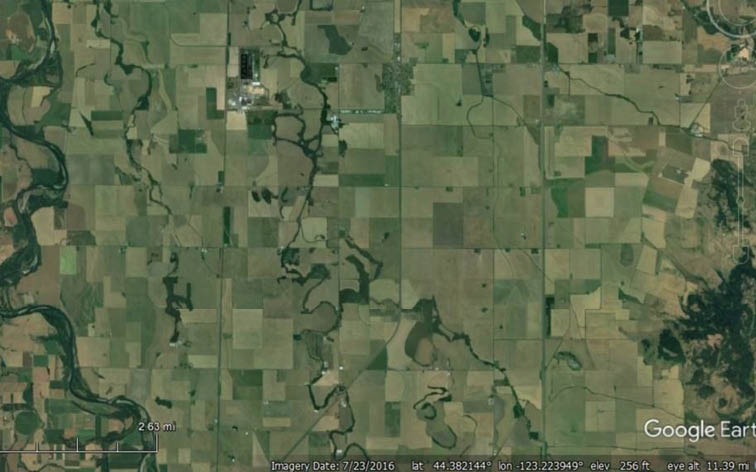
Figure 3-80 | Roadsides can connect patches of habitat
Landscapes with isolated or fragmented natural habitats make it difficult for pollinators to move from one natural area to another. The landscape shown in this photograph has poor connectivity between natural areas (dark green riparian and forested areas) because of agricultural land use, however, the high road density creates opportunities to connect isolated natural areas and create migratory pathways by implementing roadside revegetation projects favorable to pollinators.
Image from Google Earth
Roadsides extend across a variety of landscapes and often contain greater plant diversity than adjacent lands. The linear shape and connectivity of roadsides may help pollinators move through the landscape (Soderstrom and Hedblom 2007), either for daily foraging or for dispersal between larger habitat patches. Evidence suggests that pollinators use roadsides as corridors to facilitate movement through the landscape in search of food or in pursuit of new habitat (Lõvei and others 1998; Ries and others 2001; Valtonen and Saarinen 2005; Hopwood and others 2010). Additionally, there is evidence of several pollinator species expanding their ranges along roadsides (Dirig and Cryan 1991; Brunzel and others 2004). Corridors like roadsides and other linear strips of vegetation may provide habitat resilience as changes in climate drive species range contractions or expansions.
It is important to consider the landscape context of the revegetation project. Developing a landscape connectivity map of the project area and adjacent lands, using information collected during the vegetation assessment (Section 3.6.1), that locates areas of high, medium, and low pollinator habitat qualities, can be a base for designing a revegetation plan that improves pollinator habitat within a larger landscape connectivity context (Figure 3-80). If resources are limited, it can be helpful to prioritize high floral diversity and cover and other factors that influence pollinators for projects that link or act as stepping stones between existing habitats on private, municipal, state, or federal lands. It is also important to prioritize those projects that can increase the connectivity of existing roadside habitat. If remnant roadside habitat exists, for example, it would be very beneficial if revegetation projects with high plant diversity were installed adjacent to or nearby.
3.9.7 Road Mortality
Roads can pose specific threats to pollinators. Roads can be a source of mortality for pollinators due to collisions with vehicles (e.g., Munguira and Thomas 1992). Roads may act as barriers to pollinator movement (e.g., Valtonen and Saarinen 2005). The prevalence of invasive and nonnative species on roadsides reduces pollinator abundance and diversity (e.g., Hopwood 2008). Finally, roadside vegetation is exposed to pollution from vehicles, which may impact pollinators (e.g., Jablonski and others 1995).
Vehicle Mortality
Collisions with vehicles are a source of mortality for pollinators that utilize resources in roadsides as well as pollinators travelling through the landscape. Mortality rates can be estimated by counting roadkill (McKenna and others 2001; Baxter-Gilbert and others 2016) but provide incomplete information. Estimates of the population sizes of pollinators using roadsides, in addition to counts of those killed by vehicles, provides a mortality rate that includes context for the proportion of the population impacted. Mortality rates of butterflies using roadside vegetation range from 0.6 percent to 7 percent of the population (Munguira and Thomas 1992) or 6.8 percent of the butterflies found on the roadside (Skórka and others 2013). Of the butterflies observed crossing roads, 2.8 percent were hit by vehicles (Ries and others 2001).
Rates of mortality due to collisions with vehicles are influenced by a number of factors. Some species of pollinators are more vulnerable to collisions than others due to their behavior or biology; species that are strong fliers, for example, appear to have lower rates of mortality than those that are not (Munguira and Thomas 1992; Ries and others 2001; Skórka and others 2013). Volume of traffic may influence rates of mortality (Skórka and others 2013); however, several studies have found that traffic volume does not consistently influence observed mortality (McKenna and others 2001; Saarinen and others 2005). The width of road or overall density of roads in the landscape may also influence butterfly response to roads. Wider roads may increase mortality rates (Skórka and others 2013) and some butterflies have decreased movement within a dense network of roads (Valtonen and Saarinen 2005).
Vegetation quality can also influence pollinator mortality: roadsides with more species of plants had fewer butterflies killed by traffic (Skórka and others 2013) (Figure 3-81). The frequency of mowing is also linked to a higher proportion of butterflies killed on roads; butterflies that had to disperse to find new habitat after roadsides were mowed may have had a greater likelihood of collisions with vehicles (Skórka and others 2013).
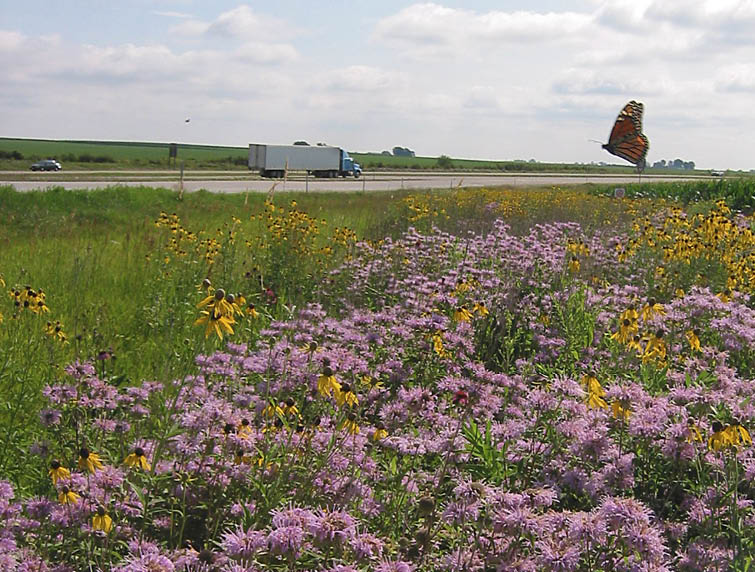
Figure 3-81 | Roadsides with high plant diversity have fewer butterflies killed by vehicles
Research indicates that fewer butterflies are killed by vehicles when roadside vegetation has high plant diversity and floral cover.
Photo credits: Maria Urice/Iowa Living Roadway Trust Fund
If quality roadside habitat is present, it may reduce the amount of pollinators killed by vehicles by providing pollinators with necessary habitat and less need to disperse elsewhere. It is important to consider increasing plant diversity of the roadside vegetation and reducing mowing beyond the clear zone (the strip of low growing or routinely mowed vegetation, or vegetation-free area, directly adjacent to the pavement) in order to reduce mortality rates due to vehicles. In areas with high traffic density, it may be helpful to increase the width of the clear zone, which is not typically used by pollinators as habitat, to increase the distance between pollinators foraging in the habitat and vehicles on the roadway. When developing the landscape connectivity map, it may also be helpful to prioritize locations for high quality revegetation projects with goals of supporting pollinators, focusing first on sites that are not in areas of high road density.
Invasive Species
Many invasive and noxious plants can be present in roadsides (Tyser and Worley 1992; Gelbard and Belnap 2003) due to favorable conditions for plant introductions and invasions (Hansen and Clevenger 2005; Von der Lippe and Kowarik 2007). Nonnative plants can decrease the quality of roadside habitat for pollinators (Hopwood 2008; Valtonen and others 2006). Nonnative plants compete with native plants for resources as well as alter habitat composition, and some cause significant reductions in the abundance and diversity of pollinators and other herbivorous insects (Samways and others 1996; Kearns and others 1998; Spira 2001; Memmott and Wasser 2002; Zuefle and others 2008; Burghardt and others 2009; Tallamy and Shropshire 2009; Wu and others 2009; Hanula and Horn 2011; Fiedler and others 2012). There is also evidence that native pollinator insects prefer native plants (Burghardt and others 2009; Wu and others 2009; Williams and others 2011; Morandin and Kremen 2013a), even though many native insects will feed on nonnative plants when few natives are available (Zuefle and others 2008; Burghardt and others 2009; Wu and others 2009; Williams and others 2011).
To reduce invasive species and nonnative plants, it can be helpful to control weeds before and during construction (Section 3.11.5), as well as during the establishment phase following revegetation (Section 3.11.6) and maintaining a weed-resistant roadside following construction (Section 3.11.4). Salvage topsoil whenever possible, and source the imported project mulch, compost, and other inputs carefully, specifying testing certificates and/or certified weed free products where possible, in order to avoid introducing and spreading weed seeds. Additionally, purchasing seeds for the revegetation project within seed transfer zones can help to curb the spread of weed seed contamination of seed mixes.
Roadside Contamination
Routine vehicle use and maintenance of roads contribute to roadside contamination by depositing pollutants, including vehicle exhaust and de-icing materials. Roadside soils and vegetation can be contaminated with heavy metals such as lead, iron, zinc, copper, cadmium, nickel, and others deposited from tire rubber, brake dust and gasoline and diesel combustion products (Gjessing and others 1984; Oberts 1986; Araratyan and Zakharyan 1988). Vehicle-derived contamination is proportional to traffic levels (Leharne and others 1992). In general, plant and soil contamination is greatest adjacent to the road and decreases with distance from the road (Quarles and others 1974; Dale and Freedman 1982; Jablonski and others 1995; Swaileh and others 2004). Contamination tends to decline within 20 meters but can still be present at high levels up to 200 meters from the road (Spellerberg 1998; Trombulak and Frissell 2000). Pollen and nectar contamination is also greatest nearest to the road (Jablonski and others 1995).
Heavy metals can be harmful to pollinators directly (Nieminen et. al 2001; Moroń and others 2010; Perugini and others 2011) or indirectly by weakening vegetation (Mulder and others 2005). However, few studies have explicitly examined the impacts to pollinators of heavy metal exposure in roadsides. Ozone, nitrates, and other exhaust gases may also have an impact on roadside vegetation and pollinators. Ozone and nitrates can inhibit floral scent, which reduces a pollinator's ability to detect flowers and in turn may reduce reproductive output of both pollinators and plants (McFrederick and others 2008). Dry deposition of particles with nitrogen derived from fuel combustion can create a strip of "fertilized" soil along roadsides, particularly in more arid regions (Gade 2013).
De-icing salts used on roads alter roadside soil chemistry by increasing sodium levels in plant tissues significantly (Snell-Rood and others 2014) and can damage plants (Bogemans and others 1989), with probable indirect impacts on pollinators (Section 3.11.9, see Deicing for Winter Safety). Varying levels of sodium in butterfly host plants can affect development of caterpillars in both positive and negative ways. Sodium is an important micronutrient for butterflies and moderate levels of sodium can increase flight muscle and brain size of adults (Snell-Rood and other 2014). More data about the impacts of salts, heavy metals, and exhaust on pollinators is needed. Until that data is available, increasing the width of the clear zone, particularly in areas with high traffic and frequent use of road salts, may help reduce pollinator exposure to these contaminants.
3.9.8 Vegetation Management
The management of roadside vegetation can have a significant impact on pollinators. Mowing vegetation beyond the clear zone multiple times a growing season, for example, can cause direct mortality to pollinators in the egg or larval stages that cannot avoid the mower (Humbert and others 2010) (Figure 3-82), can deprive pollinators of sources of pollen and nectar, as well as host plants for caterpillars (Johst and others 2006) (Figure 3-83), and can destroy bumble bee colonies (Hatfield and others 2012). However, the timing and frequency of mowing can be adjusted to reduce the impacts to pollinators (e.g. Halbritter and others 2015). When designing revegetation plans, it is important to consult with the site's maintenance department. Maintenance departments have processes and practices in place for reasons that are not obvious to habitat designers, such as the timing of mowing. Discussions with maintenance departments may result in a willingness to alter maintenance practices that can facilitate pollinator habitat, but that determination cannot be made without the designer opening communication with roadside maintenance.
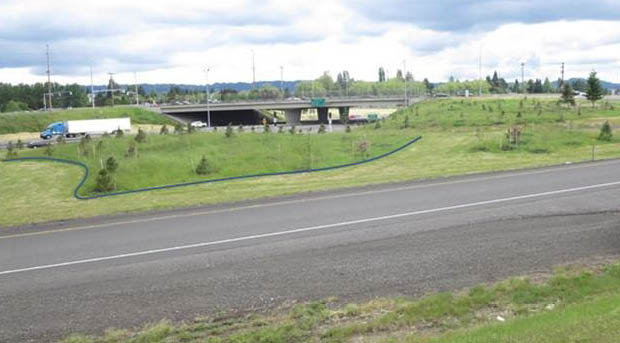
Figure 3-82 | Mowing pattern can facilitate pollinator habitat
Cutting the clear zone with well-defined edge looks groomed and provides safe run-off zone.
Photo credit: Magnus Bernhardt/ODOT
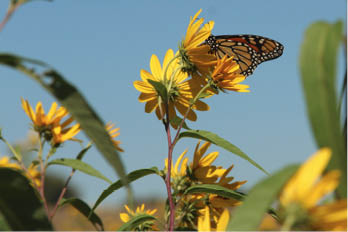
Figure 3-83 | Mowing can affect food sources
If mowing occurs too frequently, plants will not be able to flower and pollinators will have fewer sources of food.
Photo credits: Jennifer Hopwood/Xerces Society
If maintenance practices cannot be adjusted in ways that support pollinators, there are other opportunities for pollinator habitat on land managed by DOTs that are not roadside rights of way. These areas include DOT "back 40" lots, stockpile lots, maintenance yards, under used DOT office land, special management areas, bicycle paths, scenic viewpoints or historic or geologic points of interest or roadside rest areas. Maintenance is often glad to put forthright uses to these underutilized areas. These areas also offer opportunities for collaboration with citizen groups because they are less exposed to the hazards of traffic and DOTs may be more willing to allow volunteer groups to install or manage pollinator gardens in these areas.
If one of the goals of the project is to support pollinators, it is important that the vegetation can be managed such that pollinators benefit. For additional information about vegetation management and strategies that can support pollinators, see Chapter 7.

